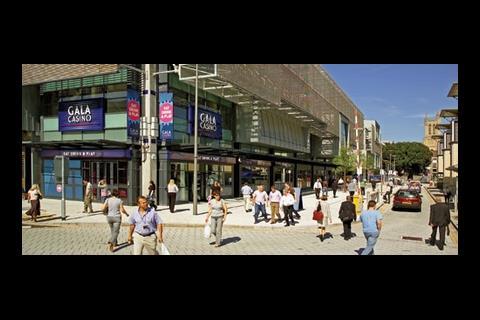How can we make sure that mixed-use opportunities are not missed opportunities? Well, David Chapman’s six key pointers to mixed-use development should help
We all know Britain is now a centre for mixed-use, mixed-income and sustainable communities. Nobody really knows what it means but most readers are probably attempting to deliver one in some form. Many evolving regeneration schemes are still on the drawing board and those that have hit the perils of implementation will no doubt be struggling with the complexity of achieving the mixed in mixed-use development. Here are some key pointers to delivering mixed-use facilities.
1 — Engage with potential operators. Don’t expect them to come to you
Engaging the existing community and stakeholders is a well-established tool in helping develop a strategy for change. Most strategies focus single-mindedly on the existing community and rarely tackle the more tricky issue of incomers and future stakeholders. Rarely does engagement address the business community required to fill the new commercial space proposed in a masterplan, the shopkeepers required to run and create the local vitality of the proposed high street and the proprietor of the anchor store; the new supermarket, the health centre or even the local pub. Engaging with likely operators, establishing their needs and aspirations and understanding their business plan will provide significant market intelligence above and beyond the standard retail and market assessment.
2 — Footfall is critical. Be realistic about what your scheme can deliver and sustain
Can everything be mixed-use? Probably not but we ask for it, our schemes desire it, our policies promote it and our designers love it. At proposal stage, artists’ impressions of a scheme rightly highlight the benefits of facilities, with most focusing on the vitality of the place created whether that is on a city, neighbourhood, street or building scale. Few, if any, highlight the risks and pitfalls of not understanding the market, placing facilities in the wrong location or the simple danger of oversupply.
We have all probably visited the failed neighbourhood centre tucked away in a housing area that has neither a local population density great enough to support it nor the additional footfall from passing trade, movement or public transport. Most will have wandered around some of our great cities and pondered on the new building form – floating residential. These homes are separated from the ground by a full storey of retail or commercial use that was never delivered or occupied. This new form does nothing to improve the quality of our cities or towns.
Both these examples highlight the need to be highly sensitive to changing market conditions, to what a scheme can deliver, based on location, connections, uses and population. These schemes are usually best placed as close to activity and movement as possible.
Plan your scheme to allow flexibility for operators.
3 — They know their business better than you
To deliver facilities, you need to be flexible while keeping your principles. Most clients, stakeholders and consultants have a good broad understanding of the facility desired but they are not the expert; the expert is usually the operator. The operator has a clear understanding of their market, their business strategy, types of place they like to work in and new markets they want to enter into. Most are happy to talk, and many can provide basic information that may make the difference between mixed-use or missed use.
4 — Understand that your plan is a marketing strategy. Many operators see you as just one in a long list of opportunities
Is masterplanning a process for shaping a strategy for change or part of a marketing strategy to draw in potential investors, developers and operators? A good plan probably covers all and should allow you to sell the benefits of bringing an operation to your area, place or project over your competitors. To achieve this, the plan must be grounded in a deliverable vision, address the general requirements and aspirations of the targeted type of operator, provide them with a clear picture of how they fit in and establish when everything else happens. Basically it is advantageous to provide a clear and confident plan that allows organisations to assess the opportunity and enter into informed discussions.
5 — Don't be afraid of change. Achieving mixed-use is a long-term game
None of us really knows what is going to happen in the future but we plan for long-term change, which may take decades to deliver. To achieve the goals of good places and facilities we need to accept change and be responsive to it as the need arises. We need to ensure we haven’t fixed too many physical aspects of development (that may end up being prohibitive to development) while clinging strongly to the principles that will help create a successful place. Basically, know where you are prepared to negotiate and where you are not.
6 — Don't be afraid of the anchor store. It will be the one that attracts customers and local operators
In many ways urban retail, and its arch enemy the shopping mall, share a common DNA that capitalises on accessibility, movement, collectiveness and some form of anchor. They diverge in their approach to location and form but both require an anchor and reason to be. On a city scale anchors include civic facilities, destination retailers and cultural uses; on a local scale anchors include the local supermarket, library, leisure centre, school or health buildings. These facilities underpin further operators, provide a destination, enhance footfall and help maximise the potential for business survival and success. To ensure success and the provision of mixed use rather than missed opportunity, the process of successfully attracting the right anchors should start on day one and never finish.
The above commentary is informed by practical masterplanning experiences across the UK. Where successful delivery of facilities did occur, it was guided by a clear strategy for action and little was left to chance. Where elements were left to chance or unresolved, the facilities have often remained fully or partially undelivered.
Key lessons learnt from these experiences include the importance of understanding how an operator works and their needs; what could realistically be developed and sustained; and, critically, understanding and appreciating the aspects of urban development that can be negotiated around without losing sight of the overall principles behind placemaking. In conclusion, this usually requires a robust, deliverable and understandable plan that embodies flexibility for negotiation.
Source
RegenerateLive
Postscript
David Chapman is director of Steppdesign



















No comments yet